Potential prognostic determinants for FET::CREB fusion-positive intracranial mesenchymal tumor
- PMID: 38291529
- PMCID: PMC10826246
- DOI: 10.1186/s40478-024-01721-2
Potential prognostic determinants for FET::CREB fusion-positive intracranial mesenchymal tumor
Abstract
Intracranial mesenchymal tumor (IMT), FET::CREB fusion-positive is a provisional tumor type in the 2021 WHO classification of central nervous system tumors with limited information available. Herein, we describe five new IMT cases from four females and one male with three harboring an EWSR1::CREM fusion and two featuring an EWSR1::ATF1 fusion. Uniform manifold approximation and projection of DNA methylation array data placed two cases to the methylation class "IMT, subclass B", one to "meningioma-benign" and one to "meningioma-intermediate". A literature review identified 74 cases of IMTs (current five cases included) with a median age of 23 years (range 4-79 years) and a slight female predominance (female/male ratio = 1.55). Among the confirmed fusions, 25 (33.8%) featured an EWSR1::ATF1 fusion, 24 (32.4%) EWSR1::CREB1, 23 (31.1%) EWSR1::CREM, one (1.4%) FUS::CREM, and one (1.4%) EWSR1::CREB3L3. Among 66 patients with follow-up information available (median: 17 months; range: 1-158 months), 26 (39.4%) experienced progression/recurrences (median 10.5 months; range 0-120 months). Ultimately, three patients died of disease, all of whom underwent a subtotal resection for an EWSR1::ATF1 fusion-positive tumor. Outcome analysis revealed subtotal resection as an independent factor associated with a significantly shorter progression free survival (PFS; median: 12 months) compared with gross total resection (median: 60 months; p < 0.001). A younger age (< 14 years) was associated with a shorter PFS (median: 9 months) compared with an older age (median: 49 months; p < 0.05). Infratentorial location was associated with a shorter overall survival compared with supratentorial (p < 0.05). In addition, the EWSR1::ATF1 fusion appeared to be associated with a shorter overall survival compared with the other fusions (p < 0.05). In conclusion, IMT is a locally aggressive tumor with a high recurrence rate. Potential risk factors include subtotal resection, younger age, infratentorial location, and possibly EWSR1::ATF1 fusion. Larger case series are needed to better define prognostic determinants in these tumors.
Keywords: FET::CREB fusion; Fluorescence in situ hybridization; Genome-wide DNA methylation profiling; Intracranial mesenchymal tumor; Next-generation sequencing.
© 2024. The Author(s).
Conflict of interest statement
The authors have no competing interests to declare.
Figures






References
-
- Acosta AM, Bridge JA, Dal Cin PS, Sholl LM, Cornejo KM, Fletcher CDM, Ulbright TM. Inflammatory and nested testicular sex cord tumor: a novel neoplasm with aggressive clinical behavior and frequent EWSR1::ATF1 gene fusions. Am J Surg Pathol. 2023;47:504–517. doi: 10.1097/pas.0000000000002022. - DOI - PubMed
Publication types
MeSH terms
Substances
LinkOut - more resources
Full Text Sources
Medical

